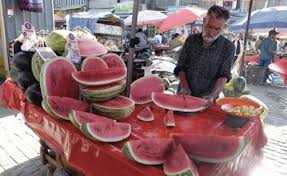
As a relentless heatwave grips Kashmir, watermelons have emerged as the ultimate summer lifesaver, driving demand—and sales—to unprecedented levels.
According to the Kashmir Valley Fruit Growers Cum Dealers Union, Srinagar’s Parimpora mandi is currently receiving around 60 truckloads of watermelon daily, generating approximately ₹72 crore worth of sales during peak months like Ramadan In early summer, average daily consumption in the valley reaches 1.35 million kilograms, accounting for around ₹2.7 crore each evening
The fruit is flown in primarily from Gujarat, Maharashtra, and Karnataka—and more recently Punjab—to meet insatiable local demand Vendors note that watermelon is one of the top-selling fruits in Kashmir, with “70 percent of shops in the mandi dealing in it during Ramadan,” driving brisk evening business
Traders explain that rising temperatures uniquely fuel this demand: “Watermelon demand shoots up massively as the temperature increases,” one vendor observed Although transportation costs inflate prices, Kashmiris continue to consume large quantities, especially during iftar and summer gatherings .
Adding another layer, local farmers in Ganderbal have begun cultivating Kashmir-grown watermelons under greenhouses. While still small-scale, this off-season production (sown March–April, harvested July–August) is proving promising .Authorities hope this could grow into a viable export niche, further boosting local incomes ~60 truckloads daily worth ₹72 crore in peak season.
Valley-wide consumption: ~1.35 million kg daily worth ₹2.7 crore.
Intense heatwave, cultural practices (like iftar).
Emerging local cultivation in Ganderbal, signaling agricultural diversification.
Watermelon has truly become the fruit of the hour in Kashmir—an enduring, refreshing symbol of resilience against the valley’s scorching summer.
As a relentless heatwave grips Kashmir, watermelons have emerged as the ultimate summer lifesaver, driving demand—and sales—to unprecedented levels.
According to the Kashmir Valley Fruit Growers Cum Dealers Union, Srinagar’s Parimpora mandi is currently receiving around 60 truckloads of watermelon daily, generating approximately ₹72 crore worth of sales during peak months like Ramadan In early summer, average daily consumption in the valley reaches 1.35 million kilograms, accounting for around ₹2.7 crore each evening
The fruit is flown in primarily from Gujarat, Maharashtra, and Karnataka—and more recently Punjab—to meet insatiable local demand Vendors note that watermelon is one of the top-selling fruits in Kashmir, with “70 percent of shops in the mandi dealing in it during Ramadan,” driving brisk evening business
Traders explain that rising temperatures uniquely fuel this demand: “Watermelon demand shoots up massively as the temperature increases,” one vendor observed Although transportation costs inflate prices, Kashmiris continue to consume large quantities, especially during iftar and summer gatherings .
Adding another layer, local farmers in Ganderbal have begun cultivating Kashmir-grown watermelons under greenhouses. While still small-scale, this off-season production (sown March–April, harvested July–August) is proving promising .Authorities hope this could grow into a viable export niche, further boosting local incomes ~60 truckloads daily worth ₹72 crore in peak season.
Valley-wide consumption: ~1.35 million kg daily worth ₹2.7 crore.
Intense heatwave, cultural practices (like iftar).
Emerging local cultivation in Ganderbal, signaling agricultural diversification.
Watermelon has truly become the fruit of the hour in Kashmir—an enduring, refreshing symbol of resilience against the valley’s scorching summer.
© Copyright 2023 brighterkashmir.com All Rights Reserved. Quantum Technologies